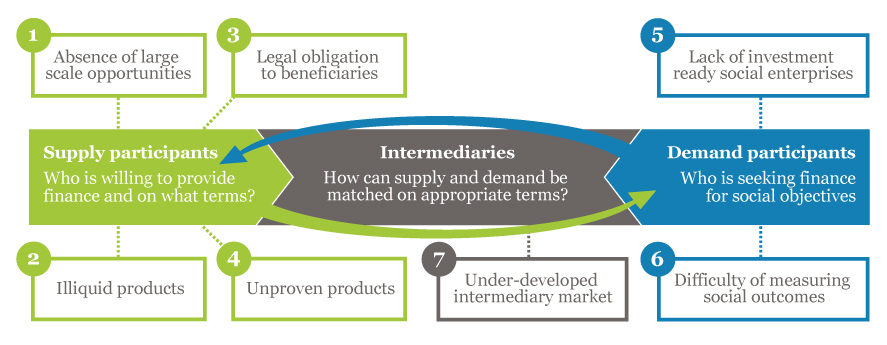
How to grow impact investing
What will it take for the Australian impact investing market to flourish? Brendan Ferguson takes a comprehensive look at the challenges and ways to overcome them.

- Despite large forecasts, the impact investing market in Australia remains fragmented and immature.
- Challenges exist on both the supply and demand sides which are not helped by an under-developed intermediary market.
- Government has a critical role to play in helping to establish an enabling environment; there are many international initiatives that can be drawn on and learnt from.
Impact investing’ refers to investment with the intention to achieve both a positive social, cultural or environmental benefit and some measure of financial return.[1] In their 2011 publication, Antony Bugg-Levine and Jed Emerson described it as ‘disrupting a world organised around the competing principle that for-profit investments should seek only to pursue financial return, while people who care about social problems should give away their money or wait for government to step in’.[2]
… just how big a ‘disruption’ are we likely to see?
UK Prime Minister, David Cameron, explained its potential, saying, ‘we’ve got a great idea here that can transform our societies, by using the power of finance to tackle the most difficult social problems’.[3]
But just how big a ‘disruption’ are we likely to see?
If the estimates of some leading analysts are to be believed, then the answer is: a very big one. A 2009 Monitor Institute report concluded that a global impact investing market of US$500bn – representing 1% of assets under management in 2008 – could be achieved as early as 2014.[4] This could include capital placed in businesses, non-profits or funds in a range of forms, such as equity, debt, working capital lines of credit, and loan guarantees. The following year, JP Morgan’s estimate was for a market of between US$400bn and US$1,000bn in the coming decade.[5] If the global impact investing market could achieve such scale, the result would be a dramatic increase in the flow of capital to the social sector.
… adoption of the Monitor Institute’s key assumption would lead to a projected impact investing market worth $20bn.
In the Australian context, where $2,000bn sits in funds under management,[6] adoption of the Monitor Institute’s key assumption would lead to a projected impact investing market worth $20bn. But the year is now 2014 and the Australian impact investing market remains fragmented and immature.
Commentators routinely cite the same landmark deals as precedent for further activity; the debt-funded acquisition of ABC Group by the SVA-led Goodstart Early Learning consortium; the NSW Government’s two ‘pay for success’ contracts, commonly known as social benefit bonds (SBBs); and the various debt, equity or quasi-equity investments of the three Social Enterprise Development and Investment Funds (SEDIFs), seeded by the Australian Government.
Working closely with SVA Impact Investing, which raised funds for the first SBB and the Social Impact Fund, SVA Consulting interviewed 20 industry leaders to better understand why the Australian impact investing market is yet to reach the scale that some have predicted.
In this article we explore the challenges, on both the supply and demand side, which investors, investees, intermediaries and government must negotiate to ensure that the market does flourish. We take a look at the international experience, pointing to a range of initiatives that Australian governments could consider in providing catalytic support to encourage the market’s development.
Challenges to the growth of impact investing
At present, deficiencies exist on both the supply and demand sides of the market. Sustained growth is constrained by the market’s capacity to match the two on appropriate terms.
We identified seven challenges to the growth of the impact investing market, each of which is explored in further detail and plotted with reference to the dynamics of the market in Figure 1.[7]

1. Absence of large scale opportunities
With the Australian impact investing market still in its infancy, the majority of deals have typically been small and relatively resource intensive. Early deals have therefore been contingent on the involvement of investors keen to build a track record for this form of investment. To achieve this, these early movers have been willing to invest time and resources above and beyond what might otherwise be considered cost effective. Typically, these have included high net worth individuals, foundations or private ancillary funds, to whom or to which scale is less important.
Until recently, such investors have maintained that deals worth less than $50m – or even $100m – are not worth their while.
STREAT’s 2012 acquisition of the Social Roasting Company’s two cafés and roasting business is a celebrated Australian social finance case study due to its innovative use of equity to fund social enterprise expansion. Yet the deal involved four separate investors, a host of pro bono legal and financial advisers and was worth only $300,000.
Top-down projections of market size – such as those referred to above – necessarily assume the engagement of mainstream institutional investors. Until recently, such investors have maintained that deals worth less than $50m – or even $100m – are not worth their while. But as interest grows, it appears as though that stance may be softening; the SVA Impact Investing team now receives regular enquiries from institutional investors – most recently from a listed insurance company and a leading industry superannuation fund – looking to direct a small percentage of their portfolio to impact investing.
In all likelihood, the path will need to be paved by trusts and foundations until a steady flow of deals can be established in the $10m to $20m bracket, at which point due diligence and other transaction costs may become sufficiently diluted to entice institutional investors to become more involved.
2. Illiquid products
Investor concerns over illiquidity arise due to the absence of an established secondary market. This issue is compounded in the context of a fund. It’s an issue for fund managers who may wish to rebalance their investments and it’s an issue for investors who may wish to sell their units. As CEO of the Responsible Investment Association Australasia, Simon O’Connor, explains, “It’s not that impact investing assets can’t be on-sold, it’s just that we haven’t yet seen how it would work.”
Internationally, organisations are pursuing innovative methods of addressing illiquidity in impact investing:
- In the UK, investment manager, Threadneedle, has partnered with The Big Issue’s investment arm to offer a cash equivalent ‘bond fund’ designed to appeal to both retail and institutional investors and offering investors the opportunity to cash out quickly. The Fund will invest in fixed income securities of organisations – companies, associations, charities and trusts – which support socially beneficial activities and economic development. Threadneedle CEO, Campbell Fleming, explains that they ‘have worked with Big Issue Invest to develop a concept that allows people to direct a portion of their savings into investments with a social benefit, through a transparent and liquid vehicle which also aims to generate a return in line with a UK corporate bond index.’ [8]
- Impact Exchange, a joint initiative between Impact Investment Exchange (Asia) (IIX) and the Stock Exchange of Mauritius, claims to be the world’s first public trading platform dedicated to connecting Asian and African social enterprises with mission-aligned investors.
- While not a stock trading platform in its own right, the Social Stock Exchange (SSE) showcases publicly listed. social impact businesses that have taken the step to evidence their impact via the publication of an impact report, thus promoting tradable stocks that generate social returns.
Such initiatives though are in their infancy and until the impact investing market achieves some level of maturity, illiquidity will remain a factor in the risk/return calculations of any potential impact investor.
3. Legal obligation to beneficiaries
Superannuation funds have pointed to legal obligations owed to their beneficiaries as an obstacle in backing investments with blended social and financial returns. The Superannuation Industry (Supervision) Act 1993 (Cth) enunciates the ‘sole purpose test’ requiring trustees to manage funds solely for the benefit of fund members.
… competitive market returns are, in fact, compatible with social returns.
There are two prevailing responses to these concerns. The first is that, with care, the requirements imposed on trustees can be navigated by integrating the objectives of impact investment into a comprehensive investment strategy that has proper regard to considerations of ‘risk, return, cash flow, diversification, liquidity, valuation data, tax, costs and the liabilities of the fund’.[9]

a veteran of private equity.
The second response is that competitive market returns are, in fact, compatible with social returns. SVA CEO, Michael Traill, is quick to point to the 12% returns enjoyed by investors in Goodstart Early Learning – Australia’s largest impact investing deal to date – which have more than doubled the average return of superannuation funds over the same period.
A third response would, of course, be for government to legislate to provide greater comfort to fund managers as to the extent of their obligations.
4. Unproven products
Mainstream investors are typically conservative and are reluctant to invest in products that do not boast an established track record. One ethical funds management group, responsible for the investment of $700m, said that it would be unlikely to consider a product that didn’t have at least a three year track record.
There is substantial overlap between each supply side challenge and the Australian impact investing market’s limited track record. As deal flow and innovation increases and investor comfort grows, such challenges will be overcome.
…institutional support for impact investing is inevitable.
Underpinning these supply challenges is, of course, the need to offer products with appropriate risk/return profiles to attract target investors. The true risk/return profile of impact investing products will only become clear over time. SBBs are a case in point. Newpin, Australia’s first SBB, was launched in July 2013 and while initial results are encouraging, we haven’t yet seen first year results and the bond is due to run for seven years.
Les Fallick, Founder and Director of Principle Advisory Services and a Director of the Fred Hollows Foundation, has identified increasing appetite for impact investing opportunities amongst institutional pension funds, particularly non-profit industry funds. “If intermediaries and investees can raise awareness and engage pension funds with a working model that offers diversification, uncorrelated risk and appropriate returns, then institutional support for impact investing is inevitable.”
5. Lack of investment ready social enterprises

Despite the importance of, and difficulties associated with, engaging institutional investors in order to achieve scale, SVA Impact Investing is unequivocal that the immediate challenge lies on the demand side of the equation.
“It’s not an absence of investors that keeps us up at night,” says Ian Learmonth, SVA’s Executive Director of Impact Investing. “Finding opportunities that are capable of generating suitable financial returns, but also meet SVA’s high standards in relation to social impact, is the challenge.”
… expressions of interest were generally flowing from insufficiently mature organisations with a need for capacity building support…
This is evidenced by the slower than anticipated allocation of funds to investment ready social enterprises by each of the three managers of the Australian Government seeded SEDIFs. The last SEDIF Progress Report, in June 2013, identified that expressions of interest were generally flowing from insufficiently mature organisations with a need for capacity building support – particularly business planning, operations and governance – rather than debt finance. SVA’s Social Impact Fund received enquiries from 102 social enterprises in its first year, four of which were deemed appropriate for investment.
However there are avenues through which start-up social enterprises may access support. For instance:
- through programs like The Crunch and Thrive, Social Traders offers early stage support to social enterprises with the aim of improving skills in commercial literacy, strategy, business planning and implementation;
- Small Giants is a boutique investment house that offers its premises to select start-up social enterprises, using the opportunity to work with them and identify prospective long-term partnerships;
- The Difference Incubator is a social enterprise that works with other social enterprises to help them become investment ready and achieve sustainability; and
- the Indigenous Social Enterprise Fund (ISEF), managed by SVA in partnership with Indigenous Business Australia (IBA) and Reconciliation Australia (RA), is one instance of a fund that has been established to improve the capacity of organisations to access more significant finance in future. IBA has allocated $1m to the fund, which offers a combination of grant funding and patient capital funding.

Whether as a direct result of such avenues of support, or otherwise, demand for social enterprise investment may gradually be responding to supply. The CEO of Social Enterprise Finance Australia (SEFA), Ben Gales, points to strong growth in SEFA’s pipeline over the last six months, which now has over $15m worth of opportunities.
Whilst acknowledging that it may have taken SEFA some time to find its feet, Gales maintains that the quality of organisations approaching SEFA for finance has improved significantly. “It has just not been a matter of SEFA looking harder and smarter,” Gales explains, “they’ve found us!”
Organisations delivering capital-intensive programs… could consider the opportunity to leverage capital from impact investors.
Also at the other end of the spectrum, there are many established organisations in the Australian for-purpose sector that are investment ready. These organisations generate tens of millions of dollars in annual revenue, and could benefit from access to social finance.
Organisations delivering capital-intensive programs – affordable housing or out of home care, for instance – could consider the opportunity to leverage capital from impact investors, particularly given the potential scale of these opportunities for investors. Capital could also be applied to upgrade ageing IT systems to improve efficiency of service delivery, or to equip an organisation to respond to sector reforms (e.g. the introduction of the National Disability Insurance Scheme or Services Connect in Victoria). These larger organisations are yet to tap into the impact investment market at a significant scale.
6. Difficulty of measuring social outcomes
The core feature of an impact investment is the pursuit of both financial and social returns. As such, the risk/return profile is inherently more complex than that of a traditional investment, which exclusively seeks financial returns. Philanthropic-minded – or ‘social-first’ – investors may be familiar with valuing social outcomes. Mainstream, ‘finance-first’ institutional investors are not.
… expectations around the rigour of measurement, evaluation and reporting of social impact will increase.
With impact investing in its infancy, investor attitudes towards social returns vary dramatically. One Singapore-based intermediary explained that “there is a lot of academic interest in impact reporting – and rightly so – but we often find that high net worth individuals (for example) are only interested in knowing that their investment has created a handful of jobs for disadvantaged people.”
This may be so, but as the market develops, expectations around the rigour of measurement, evaluation and reporting of social impact will increase.
Increasingly robust social impact reporting tools have been introduced to the sector, most notably by the Global Impact Investing Network (GIIN):
- The Impact Reporting and Investment Standards (IRIS) serves as a taxonomy, or set of standard definitions, that governs the way companies, investors and others define their social and environmental performance.
- The Global Impact Investing Reporting System (GIIRS) is an impact ratings tool and analytics platform that assesses companies and funds on the basis of social and financial performance.
…there is a lot of ground to be covered before the social sector is routinely meeting the impact reporting standards that might soon be expected by potential investors.
Sir Ronald Cohen, founding Chair of the UK’s recently established social ‘investment bank’, Big Society Capital, envisages a world in which social return is routinely calculated, expressed and presented to investment committees in a standardised form alongside financial return.[10]
Having supported hundreds of for-purpose organisations to develop measurement and evaluation processes, SVA Consulting has seen that there is a lot of ground to be covered before the social sector is routinely meeting the impact reporting standards that might soon be expected by potential investors. In our experience, organisations readily track outputs but rarely outcomes. Even less common is capturing outcomes at an organisational level and expressing the social impact generated by those outcomes in terms that investors can understand.
Indigenous Business Australia (IBA) is one organisation that is ahead of the curve. In 2012, SVA Consulting worked with IBA to develop an ‘Indigenous Economic Impact Reporting’ framework, to determine the value of beneficial social impact created through its investment activities (see Innovative thinking to measure what matters). The framework is based on the principles of Social Return on Investment (SROI), but adapted to meet IBA’s needs. IBA’s quarterly reports now align with industry best practice impact reports. With its measurement and reporting framework in place, and a better understanding of how the impact investing market can be leveraged to develop future investment opportunities, IBA is exploring ways to facilitate private investment into ventures that create impact for Indigenous people.
7. Under-developed intermediary market
The established relationships of a credible intermediary are crucial in attracting and securing investment. Traill attributes SVA’s success in filling – and even over-subscribing – the Newpin SBB and Social Impact Fund to SVA’s deep and long-standing relationships with investors.
It is not surprising, then, that commercial banks might find it difficult to effectively market impact investing products.
But the level of familiarity amongst those investors with emerging social finance products is also important. Commercial banks enjoy deep and long-standing relationships with investors, but those investors are more familiar with mainstream fixed income products. It is not surprising, then, that commercial banks might find it difficult to effectively market impact investing products to their traditional client base, as was the case with the recent Benevolent Society SBB. Intermediaries must be capable of connecting those who are familiar with and interested in investing for social impact with social sector organisations that need capital to achieve positive social change.
Beyond the crucial task of connecting those on the supply and demand sides of the market, intermediaries can:
- create and raise investment for funds;
- manage funds on behalf of others;
- design and structure financial instruments; and
- support social sector organisations with limited resources or capacity.
In Australia, the intermediary market for social investment is relatively under-developed.[11]
Overcoming these challenges
While government has a critical role to play in developing an enabling environment, investors, investees, and intermediaries can also help to overcome challenges to the growth of the Australian impact investing market.
Government
Governments in Australia have, of course, made a start on supporting the impact investing market. In addition to the $20m of Federal Government seed funding, which established the three SEDIFs, the Western Australian Government established the $10m Social Enterprise Fund in 2012. This fund aims to increase the number, effectiveness and efficiency of social enterprises in WA. In creating Australia’s first two SBBs, the NSW Government has sparked a high degree of interest amongst other state governments, particularly Queensland and South Australia, with the latter having released a discussion paper in December 2013 to explore the SBB opportunity.
Government needs to be more creative, more innovative…
But such initiatives must be sustained and must send a clear message of support for the development of a more efficient and effective, for-social-purpose capital market.
As UK Prime Minister Cameron explained ‘Government needs to be more creative, more innovative, saying to these social entrepreneurs, “if you can solve this particular social problem, we will give you money.” And as soon as Government says that – as soon as Government is brave enough and innovative enough to do that – social entrepreneurs can then go out and raise capital.’[12]
Catalytic support from government should encourage supply, demand and intermediation between the two, and may be delivered through a range of complementary interventions.
…government can play an active role as a constructive commissioner of impact investment.
On the supply side, the Australian Government could address the legal and regulatory barriers to impact investing by legitimising the consideration of social returns amongst Australian corporations, charity trustees and fund managers. This would remove any uncertainty as to the propriety of impact investments amongst institutional investors.
The introduction of incentives in the form of tax relief would further enhance the risk/return profile of such investments and help to unlock funds that might not otherwise be directed to the social sector.
As well as building an enabling environment that fosters impact investment (see the international initiatives below), government can play an active role as a constructive commissioner of impact investment. It can shift from the mindset of a purchaser of services to that of a commissioner of outcomes. Such a shift could apply across all levels of Australian government – federal, state and local – as has occurred in the UK.
In a recent submission to the Australian Financial System Inquiry, SVA advocated government support expressing the belief that no single, fixed international template could or should be adopted. Instead, SVA recognises that the international experience offers a series of lessons that could be learnt from and acted upon.
Some of the international initiatives that Australia could draw from include:
Supply
- The UK’s Charity Commission released guidance in 2012, directing charity trustees that ethical considerations may be relevant in investment decisions. A recent UK Law Commission Consultation Paper further proposes the introduction of a new statutory power giving charity trustees greater comfort that social investment is within their authority.
- Twenty US states – including corporate hub, Delaware – have enacted legislation recognising ‘Benefit Corporations’ and the legitimacy of pursuing social objectives, which may come at the expense of profit maximisation.
- In France, pension contributions must be directed to funds investing 7-10% of their assets in tackling social or environmental issues.[13]
- The UK has recently introduced incentives for social impact investment in the form of tax relief for private investment in charities, social impact bonds, community interest companies and community benefit societies.[14]
Intermediation
- The UK’s Big Society Capital, the first dedicated social ‘investment bank’, was armed with £400m from England’s dormant bank accounts and £200m from the four largest UK high street banks. Its aim is to develop an effective and efficient intermediary market and as such only invests in intermediaries. These Social Investment Finance Intermediaries (SIFIs) can make connections between socially motivated investors and social sector organisations, thus attracting more capital into the social sector than Big Society Capital alone could provide.
- In addition, Big Society Capital champions best practice and information sharing. It works with investors to embed social impact assessment into investment decision-making processes and supports social sector organisations to develop impact plans and standardised measurement and reporting processes.
Demand
- The UK’s £10m Investment and Contract Readiness Fund is dedicated to supporting social ventures in acquiring the skills to raise investment and compete for public service contracts. It offers grants of between £50,000 and £150,000 to ambitious social ventures, which aim to raise at least £500,000 of capital or want to bid for contracts worth over £1 million.
- The UK’s £10m Social Incubator Fund aims to drive a robust pipeline of start-up social ventures by increasing the focus on incubation support, and attracting new incubators into the market. The Fund aims to increase the finance available at early stages of enterprise where the financial return is too low, and/or the financial risk is too high, for Big Society Capital and other investors. There is an expectation that each social incubator supported by the Fund would offer a portfolio of intensive support over a time-limited period, with the capacity to help at least 50 social ventures over the life of the project.
Each of the initiatives outlined above could be adopted in the Australian context, many with little cost to government. In some instances (e.g. SBBs), the ultimate focus is on driving down the cost of achieving social outcomes.
However government can’t (and shouldn’t be expected to) do it alone.
Organisations seeking finance
On the demand side, those organisations seeking to access capital should focus on developing products that are accessible and attractive to potential investors. Investees could learn from the recently established Impact Investing Group (IIG) – an intermediary – which has chosen to focus its attention on property because it is perceived to be fertile ground and because investors understand it.
Large, established non-profit organisations could start thinking about ways in which they can access discounted private capital…
Small non-profit organisations and social enterprises seeking finance need to concentrate on building their capacity – in business planning, operations and governance – to ensure that they will be perceived as investment ready. Large, established non-profit organisations could start thinking about ways in which they can access discounted private capital to fund program development or necessary capital expenditure.
Where they lack the necessary expertise, these organisations can engage a recognised intermediary to support them to design and structure financial instruments, develop impact measurement frameworks and forge relationships with potential investors.
Investors
On the supply side, there is an opportunity for philanthropically minded investors – foundations, trusts, private ancillary funds or high net worth individuals – to stump-up seed funding or catalytic first-loss capital to pave the way for institutional co-investors to participate in impact investing deals. Potential investors that are unsure of how and where to identify prospective impact investments should also engage with intermediaries, which can leverage their relationships in the social sector to identify investment opportunities that match the investor’s needs.
Conclusion
Sir Ronald Cohen likens the state of the market today to that of the venture capital market in the 1970s. Cohen predicts that ‘the capital flows into impact investment are potentially huge’, but that it could take another 10 to 20 years for demand for capital to fully respond to increased supply and gather great momentum.[15]
SVA is similarly optimistic about the potential. As Traill says “SVA has invested – and will continue to invest – substantial time, energy and resources in contributing to development of the Australian impact investing market. Like many others, we are excited by the opportunity to address core social issues of disadvantage and inequality at a much greater scale.”
While in hindsight, initial projected growth rates for the market were perhaps a little bullish, once the challenges have been overcome, the potential disruption of impact investment could well be ‘a very big one’.
Author: Brendan Ferguson
[1] JBWere and DEEWR, ‘IMPACT – Australia: Investment for social and economic benefit’, March 2013
[2] Antony Bugg-Levine and Jed Emerson, Impact Investing: Transforming How We Make Money While Making a Difference, Jossey-Bass, 2011
[3] UK Prime Minister David Cameron, ‘Social investment can be a great force for social change’, July 2013
[4] Monitor Institute, ‘Investing for Social and Environmental Impact’, January 2009
[5] J.P. Morgan, ‘Impact Investments: An Emerging Asset Class’, November 2010
[6] Australian Bureau of Statistics, Managed Funds, Australia, Dec 2013
[7] Diagram adapted from JBWere and DEEWR, ‘IMPACT – Australia: Investment for social and economic benefit’, March 201
[8] See Big Issue Invest press release
[9] Kylie Charlton, Scott Donaid, Jarrod Ormiston and Richard Seymour, ‘Impact Investments: Perspectives for Australian Superannuation Funds’, October 2013
[10] Sir Ronald Cohen, ‘Revolutionising Philanthropy – Impact Investment’, 23 January 2014
[11] Rosemary Addis and Sandy Blackburn Wright, Impact Investing Australia – Financial System Inquiry Submission, March 2014
[12] UK Prime Minister David Cameron, ‘Social investment can be a great force for social change’, July 2013
[13] Sir Ronald Cohen, ‘Revolutionising Philanthropy – Impact Investment’, 23 January 2014
[14] UK Government, Social investment roadmap
[15] Sir Ronald Cohen, ‘Revolutionising Philanthropy – Impact Investment’, 23 January 2014




